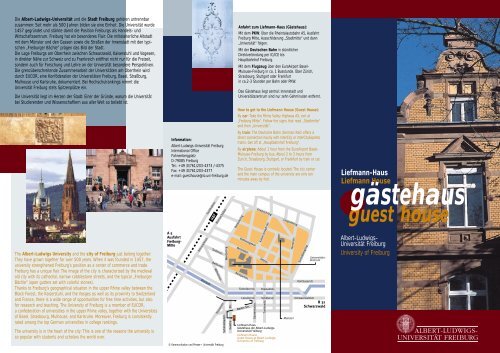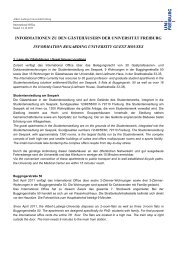guest house gästehaus - International Office - Albert-Ludwigs ...
guest house gästehaus - International Office - Albert-Ludwigs ...
guest house gästehaus - International Office - Albert-Ludwigs ...
You also want an ePaper? Increase the reach of your titles
YUMPU automatically turns print PDFs into web optimized ePapers that Google loves.
Die <strong>Albert</strong>-<strong>Ludwigs</strong>-Universität und die Stadt Freiburg gehören untrennbar<br />
zusammen: Seit mehr als 500 Jahren bilden sie eine Einheit. Die Universität wurde<br />
1457 gegründet und stärkte damit die Position Freiburgs als Handels- und<br />
Wirtschaftszentrum. Freiburg hat ein besonderes Flair: Die mittelalterliche Altstadt<br />
mit dem Münster und den Gassen sowie die Straßen der Innenstadt mit den typischen<br />
„Freiburger Bächle“ prägen das Bild der Stadt.<br />
Die Lage Freiburgs am Oberrhein zwischen Schwarzwald, Kaiserstuhl und Vogesen,<br />
in direkter Nähe zur Schweiz und zu Frankreich eröffnet nicht nur für die Freizeit,<br />
sondern auch für Forschung und Lehre an der Universität besondere Perspektiven.<br />
Die grenzüberschreitende Zusammenarbeit der Universitäten am Oberrhein wird<br />
durch EUCOR, eine Konföderation der Universitäten Freiburg, Basel, Straßburg,<br />
Mul<strong>house</strong> und Karlsruhe, dokumentiert. Bei Hochschulrankings nimmt die<br />
Universität Freiburg stets Spitzenplätze ein.<br />
Die Universität liegt im Herzen der Stadt: Einer der Gründe, warum die Universität<br />
bei Studierenden und Wissenschaftlern aus aller Welt so beliebt ist.<br />
The <strong>Albert</strong>-<strong>Ludwigs</strong> University and the city of Freiburg just belong together:<br />
They have grown together for over 500 years. When it was founded in 1457, the<br />
university strengthened Freiburg’s position as a center of commerce and trade.<br />
Freiburg has a unique flair. The image of the city is characterized by the medieval<br />
old city with its cathedral, narrow cobblestone streets, and the typical „Freiburger<br />
Bächle“ (open gutters set with colorful stones).<br />
Thanks to Freiburg’s geographical situation in the upper Rhine valley between the<br />
Black Forest, the Kaiserstuhl, and the Vosges as well as its proximity to Switzerland<br />
and France, there is a wide range of opportunities for free time activities, but also<br />
for research and teaching. The University of Freiburg is a member of EUCOR,<br />
a confederation of universities in the upper Rhine valley, together with the Universities<br />
of Basel, Strasbourg, Mul<strong>house</strong>, and Karlsruhe. Moreover, Freiburg is consistently<br />
rated among the top German universities in college rankings.<br />
The university is in the heart of the city: This is one of the reasons the university is<br />
so popular with students and scholars the world over.<br />
Information:<br />
<strong>Albert</strong>-<strong>Ludwigs</strong>-Universität Freiburg<br />
<strong>International</strong> <strong>Office</strong><br />
Fahnenbergplatz<br />
D-79085 Freiburg<br />
Tel.: +49 (0)761/203-4373 /-4375<br />
Fax: +49 (0)761/203-4377<br />
e-mail: <strong>guest</strong><strong>house</strong>@io.uni-freiburg.de<br />
© Kommunikation und Presse • Universität Freiburg<br />
Anfahrt zum Liefmann-Haus (Gästehaus):<br />
Mit dem PKW: Über die Rheintalautobahn A5, Ausfahrt<br />
Freiburg Mitte, Ausschilderung „Stadtmitte“ und dann<br />
„Universität“ folgen.<br />
Mit der Deutschen Bahn in stündlicher<br />
Direktverbindung per IC/ICE bis<br />
Hauptbahnhof Freiburg.<br />
Mit dem Flugzeug über den EuroAirport Basel-<br />
Mulouse-Freiburg in ca. 1 Busstunde. Über Zürich,<br />
Strasbourg, Stuttgart oder Frankfurt<br />
in ca.2-3 Stunden per Bahn oder PKW.<br />
Das Gästehaus liegt zentral: Innenstadt und<br />
Universitätszentrum sind nur zehn Gehminuten entfernt.<br />
How to get to the Liefmann House (Guest House):<br />
By car: Take the Rhine Valley Highway A5, exit at<br />
„Freiburg Mitte“. Follow the signs that read „Stadtmitte“<br />
and then „Universität“.<br />
By train: The Deutsche Bahn (German Rail) offers a<br />
direct connection hourly with InterCity or InterCityExpress<br />
trains. Get off at „Hauptbahnhof Freiburg“.<br />
By airplane: About 1 hour from the EuroAirport Basel-<br />
Mulouse-Freiburg by bus. About 2 to 3 hours from<br />
Zurich, Strasbourg, Stuttgart, or Frankfurt by train or car.<br />
The Guest House is centrally located: The city center<br />
and the main campus of the university are only ten<br />
minutes away by foot.<br />
Liefmann-Haus<br />
Liefmann House<br />
<strong>gästehaus</strong><br />
<strong>guest</strong> <strong>house</strong><br />
<strong>Albert</strong>-<strong>Ludwigs</strong>-<br />
Universität Freiburg<br />
University of Freiburg
Das Gästehaus der <strong>Albert</strong>-<strong>Ludwigs</strong>-Universität Freiburg in der Goethestraße: Die<br />
alte Gründerzeit-Doppelvilla aus dem Jahre 1895 liegt in Freiburgs bevorzugtem<br />
Stadtviertel Wiehre. Das denkmalgeschützte Gebäude mit seiner charakteristischen<br />
Ziegelfassade, den Erkern und Balkonen, ist im Jahr 2002 zu einem komfortablen<br />
Appartementhaus umgebaut worden.<br />
Das historische Hauptgebäude verfügt über vier repräsentative Räume nach englischem<br />
„Club“-Vorbild: Kaminzimmer, Bibliothek, und Konferenzzimmer.<br />
Im 1. Obergeschoss und im Dachgeschoss befinden sich insgesamt acht<br />
Appartements zwischen 59 m2 und 93m2 mit jeweils Wohn-/Schlafraum, Küche,<br />
Dusche/WC sowie teilweise Balkone. Auch alle Appartements im Hauptgebäude<br />
verfügen über TV-, Telefon- und Internetanschluss.<br />
Hinter dem historischen Hauptgebäude liegt der Neubau: zwei Pavillons mit insgesamt<br />
acht Appartements, die durch eine Eingangshalle mit Treppenhaus verbunden<br />
sind. Die Appartements verfügen über Wohn-/Schlafraum, Bad, WC, Küche und<br />
Balkon. Ein Appartement im Erdgeschoss ist behindertengerecht bzw. barrierefrei<br />
umgebaut. Die Appartements verleihen durch die Baumaterialien Holz, Glas und<br />
Sichtbeton dem Neubau eine leichte, transparent erscheinende Fassade. Alle<br />
Appartements bieten auf einer Fläche von 42-45m2 modernen Komfort – inklusive<br />
TV-, Telefon- und Internetanschluss.<br />
Grundriss Gästehaus Neubau,<br />
Erdgeschoss, ca. 46m2 Floor plan of the new building,<br />
ground floor, approx. 46 m2 Grundriss Gästehaus Hauptgebäude,<br />
Obergeschoss ca. 72 m2 Floor plan of the main building,<br />
second floor, approx. 72 m2 The Guest House at the <strong>Albert</strong>-<strong>Ludwigs</strong> University of Freiburg on Goethestrasse:<br />
The turn of the century twin villa was built in 1895. It is situated in the heart of the<br />
popular neighborhood Wiehre in Freiburg. The building is classified as a historical<br />
monument and features a characteristic brick façade, bay windows, and balconies.<br />
In 2002 it was converted into a comfortable apartment <strong>house</strong>.<br />
The ground floor of the historic main building consists of four impressive rooms after<br />
the English „Club“ fashion: a sitting room with a fireplace, library, a conference room,<br />
and a cloakroom. The second floor and the top floor contain a total of eight apartments<br />
of sizes ranging from 59m2 to 93m2 . Each apartment has a living room,<br />
Liefmann-Haus<br />
Das Haus war von 1894 bis 1941 im Besitz der Familie Liefmann. Die Geschwister<br />
Robert, Martha und Else Liefmann wurden im Dritten Reich wegen ihrer jüdischen<br />
Herkunft verfolgt. Robert Liefmann, ordentlicher Honorarprofessor für<br />
Nationalökonomie an der <strong>Albert</strong>-<strong>Ludwigs</strong>-Universität, wurde 1933 die Lehrbefugnis<br />
entzogen. Else Liefmann, eine angesehene Kinderärztin und von 1919 bis 1921<br />
Stadtverordnete, erhielt ebenfalls Berufsverbot. Zusammen mit allen badischen<br />
Jüdinnen und Juden wurden die Geschwister Liefmann am 22. Oktober 1940 in das<br />
Internierungslager Gurs in Südfrankreich deportiert. Robert Liefmann verstarb infolge<br />
der unmenschlichen Lagerbedingungen am 20. März 1941 im nahen Morlaàs.<br />
Den Schwestern gelang die Ausreise bzw. die Flucht in die Schweiz.<br />
Ihr Freiburger Haus wurde enteignet und 1941 von der Gestapo übernommen.<br />
Nach Kriegsende zog die französische Militärpolizei ein. Von 1949 - 2000 diente es<br />
der Freiburger Polizei als Reviersitz.<br />
Liefmann House<br />
The <strong>house</strong> was owned by the Liefmann family from 1894 to 1941. The Liefmann<br />
siblings Robert, Martha, and Else were persecuted during the Third Reich as a result<br />
of their Jewish origins. Robert Liefmann, full professor of economics at the <strong>Albert</strong>-<br />
<strong>Ludwigs</strong> University, was forbidden to teach in 1933. Else Liefmann, a respected<br />
pediatrician and member of the city council from 1919 to 1921, was likewise<br />
forbidden to practice her profession. On October 22nd, 1940 the Liefmann siblings<br />
were deported together with all other Jews from Baden to an internment camp in<br />
Gurs in the south of France. Robert Liefmann died as a result of the inhumane<br />
conditions in the camp on March 20th, 1941 in nearby Morlaàs.<br />
His sisters succeeded in escaping and found refuge in Switzerland. Their <strong>house</strong> in<br />
Freiburg was dispossessed and taken over by the Gestapo in 1941. After the war the<br />
French military police moved into the <strong>house</strong>.<br />
From 1949 - 2000 the <strong>house</strong> served as a station for the Freiburg police department.<br />
a bedroom, a kitchen, and a bathroom. In addition, several of the apartments<br />
also have a balcony. All eight apartments are equipped with television,<br />
telephone, and internet access.<br />
Behind the historic main building is the new building. It consists of two<br />
pavilions with a total of eight apartments connected to a common stairwell<br />
by way of an entrance hall. Each apartment has a living room,<br />
a bedroom, a bathroom, a kitchen, and a balcony. An apartment on the<br />
ground floor has been adapted to accommodate the disabled. The use of<br />
wood, glass, and exposed concrete for the four first floor apartments<br />
lends lightness and transparency to the façade of the building.<br />
All apartments offer modern comfort on 42 to 45m 2 of floor space and<br />
include television, telephone, and internet access.



